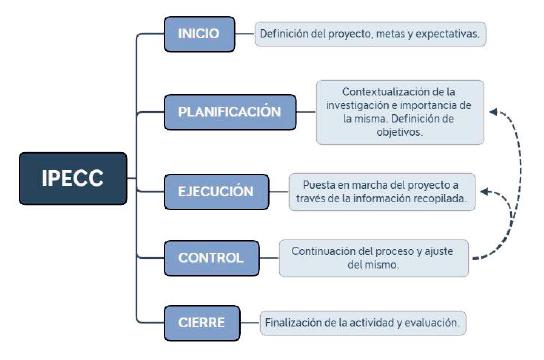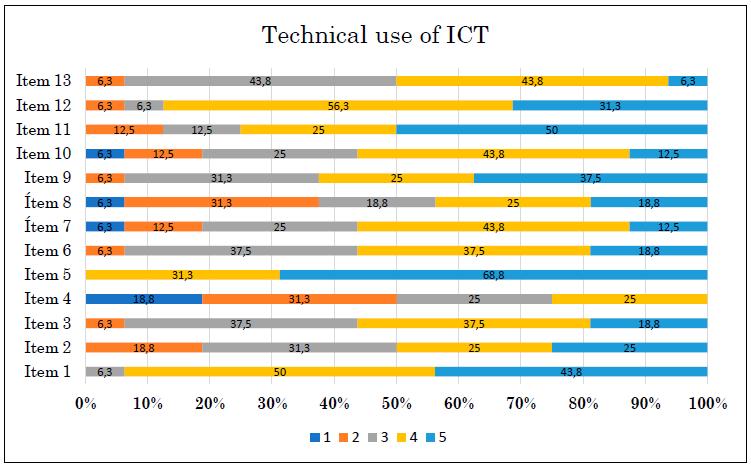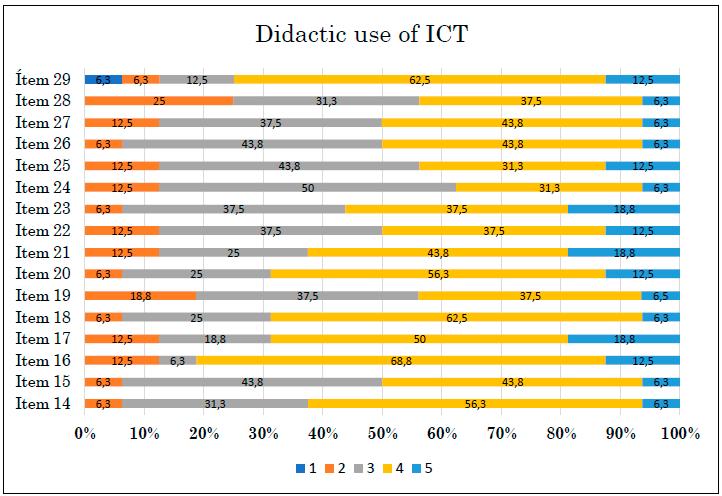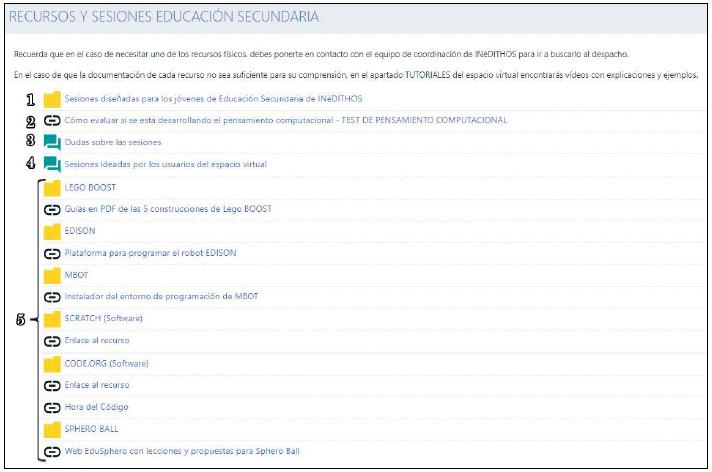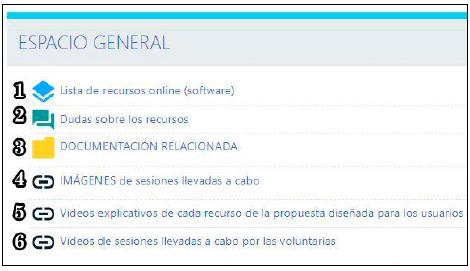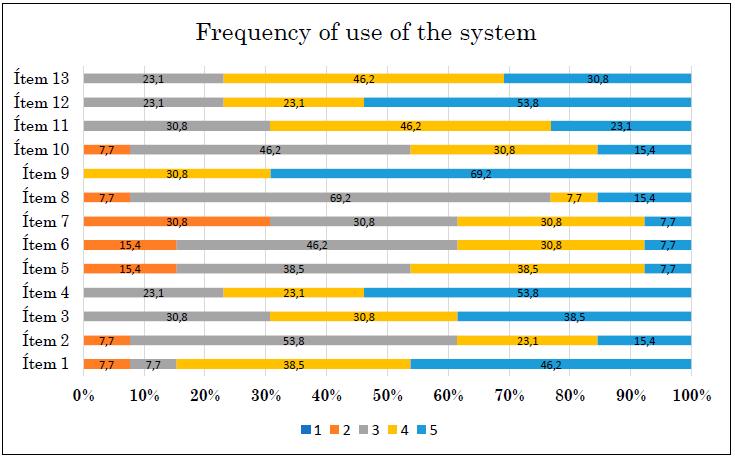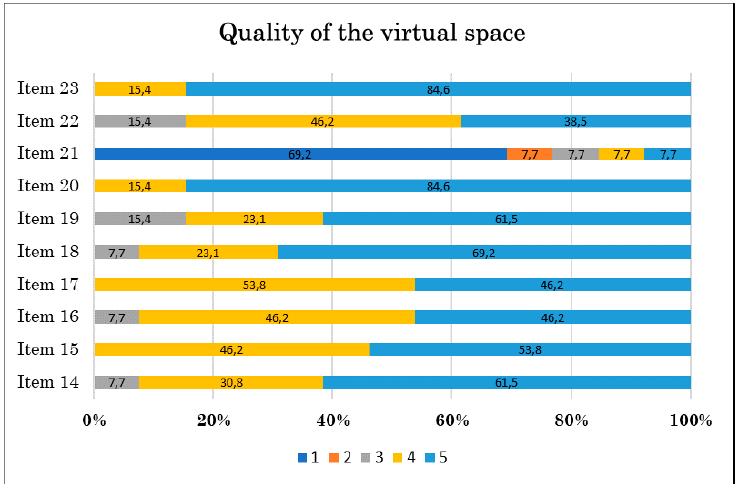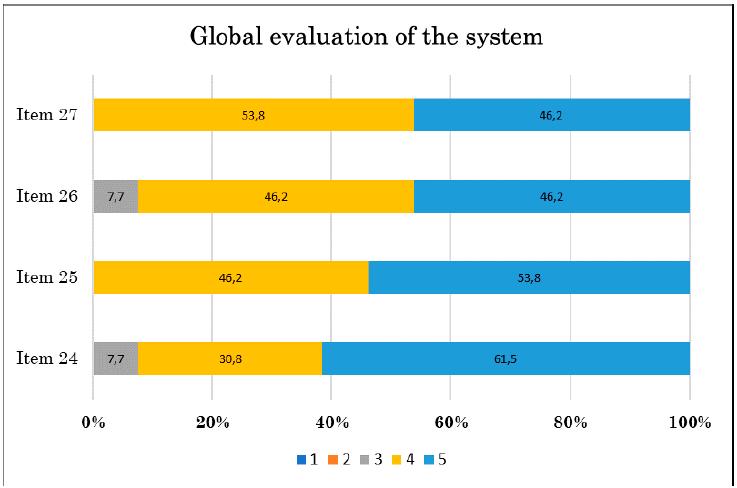Serviços Personalizados
Journal
Artigo
Compartilhar
Ensino em Re-Vista
versão On-line ISSN 1983-1730
Ensino em Re-Vista vol.28 Uberlândia 2021 Epub 29-Jun-2023
https://doi.org/10.14393/er-v28a2021-11
DOSSIÊ 1 - FORMAÇÃO DO PROFESSOR PARA O ATENDIMENTO EM AMBIENTE HOSPITALAR
Design of a didactic strategy focused on enhancing the computational thinking of young people with Rare Diseases of the INèDITHOS association1
2Doctor of Education Sciences. University of the Balearic Islands, Palma, Balearic Islands, Spain. E-mail: s.verger@uib.es.
3Graduated in Early Childhood Education. University of the Balearic Islands, Palma, Balearic Islands, Spain. E-mail: marqwhat@gmail.com.
4Graduated in Psychology. University of the Balearic Islands, Palma, Balearic Islands, Spain. E-mail: laia.riera@uib.cat.
5Doctor of Education Sciences. University of the Balearic Islands, Palma, Balearic Islands, Spain. E-mail: xisca.negre@uib.es.
Based on the educational needs of those affected by rare diseases in the field of mathematics, the design of a didactic strategy focused on enhancing the computational thinking of 3 Secondary Education participants in charge of the INèDITHOS association is proposed. In parallel, using the IPECC project management model as a focus and starting from the needs in digital skills that the volunteer team shows, a virtual training space is designed and implemented focused on the use of the resources that make up the same strategy didactic. In this way, its correct implementation is guaranteed in the context of the association, as well as examples of sessions, video tutorials, visual resources etc.
KEYWORDS: Rare diseases; Educational robotics; Computational thinking; Special educational needs; Virtual environment
Partiendo de las necesidades educativas que presentan en el campo de las matemáticas los afectados por enfermedades raras, se plantea el diseño una estrategia didáctica centrada en potenciar el pensamiento computacional de 3 participantes de Educación Secundaria a cargo de la asociación INèDITHOS. De forma paralela, utilizando como foco el modelo de gestión de proyectos IPECC y partiendo de las necesidades en competencias digitales que muestra el equipo de voluntariado, se diseña e implementa un espacio virtual de formación centrado en el uso de los recursos que componen la misma estrategia didáctica. De esta forma, se garantiza su correcta implementación en el contexto de la asociación, así como ejemplos de sesiones, videotutoriales, recursos visuales, etc.
PALABRAS CLAVE: Enfermedades raras; Robótica educativa; Pensamiento computacional; Necesidades educativas especiales; Entorno virtual
Com base nas necessidades educacionais das pessoas afetadas por doenças raras no campo da matemática, propõe-se o desenho de uma estratégia didática voltada para o aprimoramento do pensamento computacional de 3 participantes do ensino médio responsáveis pela associação INèDITHOS. Paralelamente, usando o modelo de gerenciamento de projetos do IPECC como foco e partindo das necessidades de habilidades digitais mostradas pela equipe de voluntários, um espaço de treinamento virtual é projetado e implementado focado no uso dos recursos que compõem a mesma estratégia didático. Dessa forma, sua correta implementação é garantida no contexto da associação, bem como exemplos de sessões, tutoriais em vídeo, recursos visuais etc.
PALAVRAS-CHAVE: Doenças raras; Robótica educacional; Pensamento computacional; Necessidades educacionais especiais; Ambiente virtual
Introduction
Rare diseases (RD) are concentrated in a very small sector of the population, thus the educative reality presented by those affected is hardly approached by the administrations.
According to Aguirre (2008), the educational needs that this type of students normally share are those related to: personal autonomy, sensory motor limitations, accessibility to the physical and social environment, communication and language, psychomotor rehabilitation, construction of self-image and finally those that affect the development of cognitive abilities.
In reference to the academic context, Monzón et al. (2017) concluded that subjects that require significant intellectual or physical effort such as mathematics and physical education are, generally, the most difficult subjects to follow for students with some RD.
The cognitive processes that take place during mathematical reasoning are equivalent to those that are part of the programming field. Students start from a challenge to overcome, which involves a process of reflection, trial-error and analysis. These processes are part of the computational thinking (CT).
The CT is a discipline that includes the set of thought processes that are involved in the formulation of a problem and in the expression of its solution, so that it can be carried out efficiently and correctly, contributing to the development of the abstract thinking, hence this kind of thinking in students becomes a key piece to take on challenges that education implies in the 21st century (WING, 2006, p.33).
Student's ability to think computationally will be responsible for selecting the correct options and steps to follow in order to overcome the challenge that is presented to them. Thus, the CT acquires more and more importance in a society in constant technological evolution, where the school must adapt its teaching methods to the new labor and social demands.
Nowadays, within the educational field, the technological discipline focused on the use of hardware best known for the treatment of the CT is educational robotics.
Educational robotics is a didactic approach that can be easily integrated into different educational environments, in which through the use of programmable robotic devices, and the application of project-based learning methodologies, they can improve the knowledge acquisition process of students , allowing at the same time to become familiar with ICT and use them to define a plan, organize and find a solution to a specific problem through research and experimentation (MISIRLI & KOMIS, 2014, p.99).
Teachers need information about RD and Alfaro & Negre (2019) deepen in this aspect, they carried out an analysis of the information needs presented by teachers regarding the educational care of students with rare diseases in Early Childhood and Primary Education centers of the Balearic Islands. Based on the results of the analysis, the participating teachers consider that they would be able to improve curricular competencies through educational interventions, which indicates a certain confidence in themselves, in other teachers and in the students with RD to improve their skills and competences. Even so, they recognize that the training they have is not enough, confirming the need to announce the educational needs of students with RD.
The context selected for the research is the INèDITHOS6 association, which provides a volunteer service in Mallorca (Spain). INèDITHOS (Research and Intervention for Educational and Technological Inclusion in Hospital Pedagogy) is a university volunteer project aimed at offering psycho-pedagogical care to children and young people who suffer from serious diseases, chronic in general, and, specially, known as rare diseases (RD) or infrequent diseases (VERGER; NEGRE, 2019). On the other hand, it aims to be a space open to collaboration with researchers to raise awareness about the needs of these children and young people. The association works in three intervention lines: Psychopedagogical care in the Pediatric Semicritic Unit of the Son Espases Hospital, the Pediatric Palliative Cures Unit of the Son Espases Hospital and finally, Home Educational Support, in which the research will be focused.
Through the learning-service methodology, INèDITHOS aim to combine service to the community and learning processes in a unique project in which the participants learn while they work on the real needs of the environment with the intent to improve it.
The main goal set for the research is to identify the characteristics that a didactic strategy must have to promote CT in children and young people with rare diseases that receive support from the INèDITHOS association.
This project is framed in the investigation project EDU2016- 79402-R (MINECO/ACI/FEDER/EU) “Educational solutions for the improvement of the quality of life of de child with a rare disease from an innovative and transdisciplinary intervention” and is part of an action of the project “INèDITnet: Network for the implementation of the Learning-Service (ApS) methodology in the field of Hospital Pedagogy in University Training” of the Institute for Educational Research and Innovation (IRIE) of the University of the Balearic Islands (UIB).
Methodology
The investigation has a mixed approach because it requires de use of techniques located in both the qualitative and quantitative framework. As it is a minority context and, with the intention of creating a theoretical support that can be useful in similar situations, it will be carried out through design-based research (DBR) based on different case studies. The case study approach, according to Ceballos-Herrera (2009), belongs to the qualitative interpretive paradigm, which considers that reality is constructed by the people involved in the situation under study, and although the context of each one is personal, the constructions have points in common.
Within this methodology, it has been decided to use the IPECC project management model (Initiate, Plan, Execute, Control and Close) as an implementation method (LYNCH; ROECKER, 2007). This model offers the advantage of allowing, thanks to the iterative possibilities it enables, a continuous re-evaluation of the results to guarantee a quality result, allowing the introduction of changes based on the data obtained, as well as improvements.
The role of the researcher will be to design a didactic strategy formed by a virtual environment to promote the digital skills of the volunteer team and educational proposals for each of the participants with the intention of enhancing their CT, adapting to their needs and characteristics.
Case selection
The project will be carried out within the framework of different case studies with an N=3, each of them with ages corresponding to the Secondary Education stage. In addition, none of them present the same diagnosis, so their educational needs and their own characteristics should be attended in a personalized way.
They will then briefly introduce themselves to each of the young people. For reasons of anonymity they will be identified with a code and not with their full name. The information on each of the pathologies has been extracted from the list7 of diseases offered by the Spanish Federation of Rare Diseases (FEDER), which aims to make people who suffer from a rare disease visible.
- I. (13 years old). Duchenne muscular dystrophy. it is a severe and progressive type of muscular dystrophy. Characteristic features are muscle weakness and loss of muscle mass in the body and heart. The ability to walk can be lost over 12 years of age. In some cases there are learning and memory problems, as well as communication problems.
- J. (14 years old). Coats disease and paralysis. It is a disease characterized by abnormal development of the retinal blood vessels. Presents loss of vision, deviation of the alignment of one eye in relation to the other and the appearance of a reflection or white spot in the pupil.
- Is. (16 years old). Chronic pain (Without diagnosis).
Regarding the lack of diagnosis presented by one of the participants, it should be noted that it is a very common problem within the field of RD. The delay in diagnosis means that the different needs presented by these people cannot be covered until they have a specific roadmap. Therefore, the less time it takes to diagnose a case, the less it will take to adopt the necessary measures to improve their quality of life.
Research phases
The investigation is going to take place through a project management model known as IPECC (Initiate, Plan, Execute, Control and Close), continuing with the investigation process framed in an investigation project based in design.
The IPECC model allows to repeat the cycles needed until the quality control is approved and the close phase can begin. Thus, starting from the scheme presented above, we proceed to explain each of the phases of the project:
Initiation phase. The vision of the project is articulated, goals are established and expectations are defined, as well as the scope of application. In this case, the central axis is to design a proposal focused on enhancing the CT of INèDITHOS’ youth through programming.
Plan phase. The scope is analyzed while the specific tasks and activities to be completed are identified, a project plan and calendar are developed. The scope of the objective of designing a didactic strategy to enhance the CT encompasses 3 INèDITHOS users and each of the volunteers who visit their homes weekly. On the other hand, the objective of designing and implementing a virtual training platform encompasses all the association's volunteers so that all of them can access and develop their digital skills.
Execution phase. In this phase, the results obtained on the competencies of the volunteers are analyzed and, therefore, based on their needs, the scheme of the virtual platform begins to be designed so that its implementation in Moodle is more agile. On the other hand, having data on the participants available, the selection of resources included in the future didactic strategy begins to be made, based on their needs and characteristics.
Control phase. During this phase the design and implementation of the virtual training environment will be controlled. Meanwhile, the volunteers of the association will interact with the environment and make an evaluation. At the same time, A questionnaire will be validated to attach in the virtual environment with the intention of serving as a future tool to assess possible CT-based proposals that arise from the association itself.
Close phase. Once the virtual training environment is finished, the conclusions will be drawn in which all the key aspects that have been considered for the correct design and implementation of the virtual training environment as well as the design of the PC-based didactic strategy will be detailed.
Tools used
Next, the instruments used to obtain and analyze information will be exposed, explaining in turn the necessary adaptations that have been made for its application in the context of volunteering in the association. In order to reach the volunteer team, the questionnaires have been sent through the Google Forms platform.
Primary Education teacher perception questionnaire on competency-based student learning (Meroño, L. et al., 2016).
Given the need to know the current capacities of the young people to whom the didactic strategy will be directed, the selected instrument allows to collect information on their general competences using a Likert scale from 1 to 5. For this, the items have had to be adapted to other equivalent to the stage of Secondary Education. In a complementary way to the adaptation of the items, and in order for the sessions to be as personalized to each case, 11 open questions were added to find out the participant's personality, hobbies, electronic devices they have, among other aspects.
Process of adapting the questionnaire to Secondary Education
For the adaptation of the questionnaire to Secondary Education, indicators corresponding to the educational stage have been selected in Decree 34/2015, of May 15, which establishes the curriculum for compulsory secondary education in the Balearic Islands and, on the other hand , in Order ECD / 65/2015, of January 21, which describes the relationships between competencies, content and evaluation criteria for primary education, compulsory secondary education and high school.
TABLE 2: Example of the process of adaptation8 to Secondary Education of the items of the Education teacher perception questionnaire Competency-based primary (MEROÑO, L. et al., 2016).
| Original questionnaire items | Justification for the change | Items adapted to Secondary |
|---|---|---|
| 1. Is capable and wants to know the parts and functions of the human body, for example, the systems. | The item is the same but written as it appears in the Secondary Education Curriculum. | 1. Identify the components of the digestive, circulatory, respiratory and excretory systems, knowing their functioning. |
Source: Own elaboration.
ICT skills questionnaire for teachers of different educational levels (de la IGLESIA, J. et al., 2016).
When establishing the content to be included in the virtual space, the training needs of the association's volunteers must be taken into account. Due to the fact that a large part of the volunteers study the Primary Education and Early Childhood Education Degree and/or are active teachers, the selected questionnaire encompasses all the educational stages in the same instrument. The questionnaire is made up of 45 indicators that can be evaluated using a Likert scale from 1 to 5, separated into three large groups: technical use (13), didactic use (16) and media design (16).
Questionnaire for assessing the quality of a learning management system (LÓPEZ, I. L. et al., 2018).
To offer a virtual space that adapts to the training needs of the volunteers, it is necessary to know their degree of satisfaction with the platform once it is implemented, in order to make the pertinent modifications and ensure that the environment encourages significant use. The questionnaire originally has 33 questions categorized into three different sections: Frequency of use of the system, quality of the system and global evaluation of the system. For its application9 to the volunteers of the INèDITHOS association, the terminology of two questions had been modified and, on the other hand, four questions that interpreted the virtual space as a subject to be taken have been deleted, and therefore, useless for the case in question.
Educational robotics resources used
The resources that will be part of the didactic strategy and the virtual training space have been selected from those that are accessible to the association or are already part of its property, among which are: Scratch, mBot, Sphero ball mini, Hour of Code, Edison, Lego BOOST, Makey Makey and Megamaker Kit.
Results and Discussion
For the design of the didactic strategy, the results that each volunteer gave on the young person who volunteered weekly at home were collected through the Primary Education teacher's perception questionnaire on competency-based student learning (MEROÑOL et al., 2016), adapted to Secondary Education.
Once the general competencies, characteristics10 and hobbies of the three young people have been assimilated, the didactic proposal for each of them is presented. Each proposal consists of five sessions designed to be carried out with a temporality close to forty minutes, adapting to the normative duration of the volunteer activity (hour and a half) and to the electronic devices available to the young person.
TABLE 5: Results of each participant.
| Questionnaire indicator | I. (13 y.o.) | Jo. (14 y.o.) | Is. (16 y.o.) |
|---|---|---|---|
| 1 | 2 | 4 | 4 |
| 2 | 2 | 2 | 5 |
| 3 | 2 | 4 | 5 |
| 4 | 3 | 1 | 5 |
| 5 | 4 | 4 | 5 |
| 6 | 2 | 2 | 4 |
| 7 | 1 | 2 | 4 |
| 8 | 1 | 2 | 3 |
| 9 | 1 | 3 | 4 |
| 10 | 1 | 1 | 4 |
| 11 | 2 | 1 | 4 |
| 12 | 1 | 2 | 4 |
| 13 | 1 | 2 | 4 |
| 14 | 1 | 3 | 4 |
| 15 | 2 | 1 | 3 |
| 16 | 3 | 4 | 4 |
| 17 | 1 | 3 | 4 |
| 18 | 2 | 2 | 4 |
| 19 | 3 | 4 | 5 |
| 20 | 3 | 4 | 5 |
| 21 | 3 | 4 | 4 |
| 22 | 2 | 3 | 3 |
| 23 | 2 | 3 | 3 |
| 24 | 1 | 2 | 4 |
Source: Own elaboration.
- I. (13 y.o.). 11 The first session We program a story will introduce the Scratch environment and some of the blocks that compose it through a tutorial offered by the platform itself to create characters and move them. In the second session we create a video game, using a video tutorial incorporated into the virtual training space designed, the young person must follow the guidelines set forth, thus assimilating the X and Y angles using Scratch. In the third session Do not get out of line, the mBot robot is incorporated to show its operation through a route created with insulating tape on the ground, with the objective of programming the line follower so that the robot does not get out of tape. In the fourth session Not all robots have the same shape, thanks to Sphero Ball, you will test your programming knowledge by blocks to avoid obstacles using the robot. As a last session, in How Minecraft was made, taking advantage of his love for video games, he will use the platform La hora del Código to take the lesson 19 of the quick course and learn the internal aspects of Minecraft video game programming in a playful way.
- Jo. (14 y.o.). 12 In the first session The mechanical arm, thanks to the Lego BOOST pieces, will build and program a small mechanical arm that will then use to check if it resists the weight of some objects in his home.
In the second session, he will carry out, like the previous participant, the proposal Not all robots have the same shape. The third session Dodge the obstacles will allow Jo to create a path on the ground with objects from his surroundings to avoid obstacles by programming the Edison robot. In the fourth session Controlling the traffic, some components of the Megamaker Kit will be used to create and program a traffic light, following a series of instructions proposed on the Ebotics website. Finally, in the last Learning to Drive session will combine the last two activities by programming Edison to stop when the light is red and move forward when it is green.
- Is. (16 y.o.). 13 Due to the fact that is a very curious person when faced with new situations and eager to learn, has sought a wide variety of resources. In the first session We Create a Video Game Is. will create a video game based on the popular game Pong using Scratch, following a series of guidelines in a video tutorial included in the virtual training space. The video game can be controlled with Makey Makey connected to any everyday object. The second session will be The Mechanical Arm (Lego BOOST), explained above, as well as the third session will be Not all robots have the same shape (Sphero Ball Mini). The fourth session will be Don't get out of line, corresponding to the mBot resource, which must be programmed so as not to get out of the duct tape route. To finalize the proposal, Is. will create and program just like Jo. a traffic light, thus converging motor skills and cognitive skills.
For the design of the virtual training space focused on the use of CT resources, were used the results that the 16 volunteers showed in the three dimensions of the ICT Competency Questionnaire for teachers of different educational levels (de la IGLESIA; FERNÁNDEZ; CEBRERIRO, 2016).
Once the data from the first section has been collected, it is observed that in all the items there is at least one volunteer who feels that she is not competent at all regarding the use of ICT. Similarly, all the questions have a higher percentage of responses above the average score (3), so it will be positive for the implementation of the virtual space. The indicators in the second graph show a more regular trend than in the previous case. In a resounding way, the volunteers in general feel competent in the use of ICT for educational purposes. In this way, the use of educational robotics is not perceived as problematic if it is accompanied by adequate virtual training.
Finally, in the third and last section that will be presented below, there is a large number of items in which there are two volunteers who do not feel capable, in some cases reaching more than a third of participants who perceive themselves as nothing competent. As some of these items imply the use of software as a teaching tool, it will be considered when defining them in the virtual space, offering tutorials and documentation that help facilitate the implementation of this kind of resources.
The design and development of the virtual training space has been carried out using the Moodle platform, taking into account the results shown above. Therefore, taking into account the needs of the volunteers regarding the use of educational software for didactic purposes, it has been ensured that the implementation of virtual resources is explained in the most detailed and accessible way possible.
Thus, we proceed to present the virtual training space focused on Secondary Education consisting of four sections (Resources and sessions, General space, Tutorials and Extension). Thus, in the image the sections are listed to explain them later.
Sessions designed for young people in Secondary Education. This section includes the detailed guides of the sessions proposed for each participant, this way, each volunteer will be able to know the resources that will need for the activities and the objectives that are intended to be covered.
Computational Thinking Test (Román, 2015). Questionnaire that allows knowing the CT level of Secondary Education students in terms of questions and approaches based on block programming. By being implemented as Pretest and Posttest, the volunteers will be able to know how much the CT has been enhanced with the didactic strategy.
Doubts about the sessions. Space that allows INèDITHOS volunteers to make any questions about the activities to be implemented.
Sessions devised by users of the virtual space. Space enabled to share experiences based on CT devised by the volunteers themselves.
Lego BOOST, Edison, mBot, Scratch, Code.org and Sphero Ball. Within each of the folders, the volunteer has at her disposal a PDF file with a brief description of the material and examples of sessions with it. In the case of software resources, links have been attached on the main page that will facilitate access to the content by the volunteers.
The General Space section is made up of the following elements:
List of software resources. Collaborative Wiki with online software based on PC, described and with access link. For example: Lightbot, Gamesonomy o Compute It!.
Doubts about resources. Forum for questions related to any of the resources that are included in the software wiki.
Related documentation. Readings related to RES and/or educational robotics in contexts similar to the one presented by the association.
Images of sessions carried out. Link to the Drive folder where you can share images of the sessions that the volunteers put into practice with the participants.
Explanatory videos of each resource of the proposal of each user. Link to a private playlist linked to the association's YouTube channel with videos about the resources that make up the didactic strategy.
Videos of sessions carried out by the volunteers. Link to another playlist where, through the channel coordinator, the volunteers will be able to attach videos recorded by themselves about the sessions they have implemented.
As part of the control phase of the IPECC cycle, the virtual training space was evaluated by the 16 members that make up the volunteer team of the INèDITHOS association, of which 13 responded. Through the application of the Questionnaire to evaluate the quality of a learning management system (López, I. L. et al., 2018), the necessary data was obtained to implement changes that respond to the needs presented by the users.
The results show a very positive assessment in all aspects, however, the indicators that refer to communication through the environment (5, 6 and 7) are more affected because the volunteers have the telephone number of their companions and they have priority for using instant messaging systems like WhatsApp. The second graph, as in the first, shows how the volunteers believe that they have a quality environment. In the case of indicator 21, there were doubts due to a misunderstanding that the volunteers reported once the questionnaire had been sent, since they were not aware that the high rating suggests that the platform has navigation problems.
In the third graph, the assessment of the volunteers regarding the quality of the virtual space is more than satisfactory in the four indicators. Therefore, taking into account the three dimensions analyzed, it can be affirmed that the training environment obtains a positive validation from the users. On the other hand, the comments that the volunteers included in the questionnaire have been taken into account when modifying the space as part of the IPECC cycle. The changes introduced refer to download errors of some files that have been repaired today, and a lack of understanding of some elements that have been minimized by adding a brief description visible in the main menu.
Thus, the design and development of the virtual CT-based training environment for the INèDITHOS association is concluded. The questionnaire used for the evaluation of the space (López, Zapata, Briceño and Poot, 2018) will be left permanently for future modifications. Finally, a contact email will be attached for any problem that may arise in the space.
Conclusion
The objective of this article was to identify the characteristics that a didactic strategy must have to promote the CP of young people with RD from the INèDITHOS association. Consequently, a series of aspects have to be considered when designing and implementing the sessions.
The proposed activities must be based on hobbies and tastes of the young person to whom they are directed. For this, it will be essential that the volunteer who carries out the activities with each of them is the same one who goes to the home weekly to provide the volunteer service. In the event that it was an unknown person, the lack of connection could affect the development of the proposal due to a possible discomfort of the young person.
When designing a proposal, the volunteer must detect the general competencies of the young child, as well as the educational needs that they present in any field beyond mathematics. Once the general competencies are known, the key characteristics of the suffered disease should be understood, since when designing a didactic proposal it will be necessary to take into account to what extent the disease implies some limitation at a motor and cognitive level.
Regardless of whether the child or youth is in school or not, one should avoid confusing biological age with cognitive age. It is common to find occasions where the difference between these two ages is greater than five years. In these cases, the biological age is nothing more than a label, so the initial degree of difficulty of the didactic strategy will be established based on their knowledge and not based on the biological age or course to which it belongs. Thus, the degree of difficulty of the sessions must always be increasing, so it is advisable to assiduously reinforce previously worked concepts, trying to get the child or young person to verbalize the steps they take during the activity process for better internalization.
Sessions must strike a balance between duration and effectiveness. An activity of excessive duration, even if it is made up of different resources, concepts and interventions on the part of the child, can be counterproductive due to the mental exhaustion it entails. Therefore, a short-term proposal that is flexible to be lengthened in the event that the interest of the child stands to will always be prioritized.
The volunteers must have at their disposal a virtual space to go to in order to train themselves in order to prepare and / or implement a didactic strategy. A visually attractive and tidy space where you will find resources that you can include in the proposals and ideas of how to implement them in the context of the association, in a clear way that encourages their use. The presentation of the resources and activities greatly influence the predisposition to carry them out, so the volunteer must guarantee an attractive introduction of the proposal for the young person. In turn, in case of doubt between a physical resource and a virtual one, priority will always be given to the physical one (as long as the child or young person can establish contact with it). The fact of physically interacting with the material stimulates action and the sense of touch, something that virtual resources do not offer.
REFERENCES
AGUIRRE, P et al. Enfermedades raras y crónicas. Manual de atención al alumnado con necesidades específicas de apoyo educativo por padecer enfermedades raras y crónicas. Junta de Andalucía, 2008. Disponible en: http://hdl.handle.net/11162/3178. [ Links ]
ALFARO, A. y NEGRE, F. Análisis de las necesidades de información que presentan los docentes respecto a la atención educativa del alumnado con enfermedades raras. Revista Electrónica Interuniversitaria de Formación del Profesorado, v. 22, n. 1, p. 175-194, 2019. DOI: https://doi.org/10.6018/reifop.22.1.326341. [ Links ]
CEBALLOS-HERRERA, F. A. El informe de investigación con estudio de casos. Magis. Revista Internacional de Investigación en Educación, v.1, n. 2, p. 413-423, 2009. Disponible en: https://bit.ly/2OgiFXM. [ Links ]
FERNÁNDEZ DE LA IGLESIA, J. et al. Desarrollo de un cuestionario de competencias en tic para profesores de distintos niveles educativos. Píxel-Bit. Revista de Medios y Educación, v. 0, n. 48, p. 135-148, 2016. DOI: http://dx.doi.org/10.12795/pixelbit.2016.i48.09. [ Links ]
LÓPEZ, I. L. et al. Diseño y validación de un instrumento para evaluar la calidad de un sistema de gestión de aprendizaje. Tecnologías y Aprendizaje: Investigación y Práctica, p. 411-418, 2018. Disponible en: https://bit.ly/2y78n7F. [ Links ]
MEROÑO, L. et al. Diseño y validación del cuestionario de percepción del profesorado de Educación Primaria sobre el aprendizaje del alumnado basado en competencias (# ICOMpri2). Revista Complutense de Educación, v. 29, n. 1, p. 215-235, 2016. DOI: http://dx.doi.org/10.5209/RCED.52200. [ Links ]
MISIRLI, A., y KOMIS, V. Robotics and programming concepts in early childhood education: A conceptual framework for designin educational scenarios. Research on e-Learning and ICT in Education, v. 0, p. 99-118, 2014. DOI: https://doi.org/10.1007/978-1-4614-6501-0_8. [ Links ]
MONZÓN-GONZÁLEZ, J. et al. Alumnado con enfermedades poco frecuentes y escuela inclusiva. Octaedro, 2017. [ Links ]
LYNCH, M. M. y ROECKER, J. Project managing e-learning: A handbook for successful design, delivery and management. Routledge, 2007. [ Links ]
ROMÁN-GONZÁLEZ, M. et al. Test de Pensamiento Computacional: diseño y psicometría general. III Congreso Internacional sobre Aprendizaje, Innovación y Competitividad (CINAIC 2015). DOI: https://doi.org/10.13140/RG.2.1.3056.5521. [ Links ]
NEGRE, F. y VERGER, S. INèDITHOS. Intervenció i investigació educativa i tecnológica en Pedagogia Hospitalaria. Bones Pràctiques en Entorns Pedagògics. Universitat de les Illes Balears, v. 3, 2019. Disponible en: https://bit.ly/2UrXsxx. [ Links ]
WING, J. Computational Thinking. Communications of the Acm, v. 49, n.3, p. 33-35, 2006. DOI: http://dx.doi.org/10.1098/rsta.2008.0118. [ Links ]
8Complete process of adaptation of the questionnaire to Secondary Education: https://bit.ly/3fkXYG8.
9Modifications implemented in the Questionnaire for assessing the quality of a learning management system (LÓPEZ, I. L. et al., 2018): https://bit.ly/3fnYPpw.
10Results of the open questions of the Primary Education teacher's perception questionnaire about student learning based on competencies (MEROÑOL, L. et al., 2016): https://bit.ly/2ZZz1tq.
Annexed
Carpeta contenedora de Google Drive con los documentos externos adjuntados como notas a pie de página: https://bit.ly/3iY5sB2.
Received: April 01, 2020; Accepted: December 01, 2020











 texto em
texto em 


